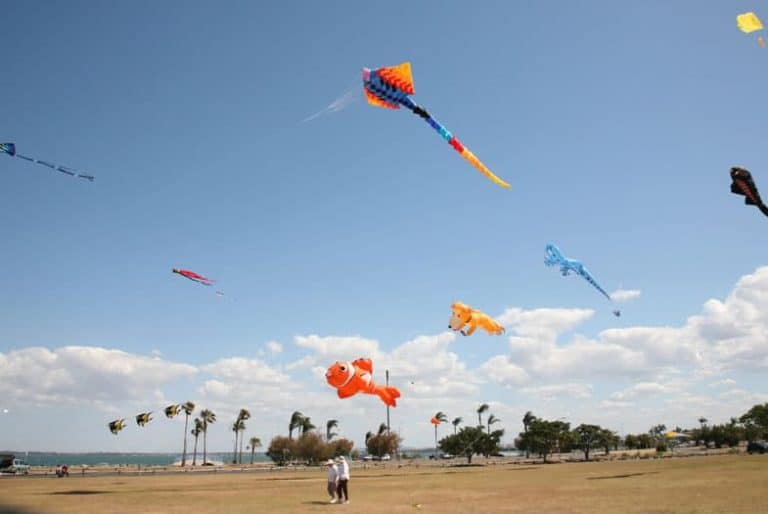Can You Fly A Kite Into The Wind?
Are you interested in joining the kite flying club? Are you curious as to how kites fly and how they stay airborne? In this article, we speak in-depth about kite flying and the wind’s role in this sport.
You can fly kites into the wind as it is the only way to launch these aircraft. Wind speeds have to be moderate (8-24mph). Extremely light winds can lead to launching failure, while powerful kites can lead to kites crashing.
Do You Need Wind To Fly A Kite?
We all know that a kite requires wind to function, and mostly a good amount of wind, not just any slight breeze. The size and weight of the kite matter a lot because if the kite is heavier, it would require more wind. But the wind speeds needed for lighter and smaller kites will be less than a heavier one. (source)
According to traditional methods, to detect whether the weather is good enough, one must point out a couple of things in the environment to make a judgment. One of the ways is if one can feel the wind on their faces, then the wind is enough to fly. Another is to look for rustling leaves; check how much it moves if a flag is on-site. (source)
The Beaufort Scale
The wind is the engine that keeps the wind moving at its pace. The wind and weather sometimes can be very unpredictable, which in 1805 caused Francis Beaufort to devise the Beaufort Wind Force Scale.
The Beaufort scale helps one estimate the wind speed without using instruments but instead on the physical environment. This method comes in handy, especially when one has no tools on-site to measure the wind. It can measure wind speeds at both sea and land.
Using a anemometer is another method used. An experienced kite flier knows how to detect the environment and whether it is suitable for flying a kite. The bottom line is even though the wind is invisible, there are ways one can know how to measure the wind.
As a kite flyer, one should know what wind speed is best for flying and which one is too little to prevent going out during less favorable conditions. Launching the kite or keeping it at a regular position in the air becomes problematic when there is little wind. Strong wind, however, can result in either the line snapping or the kite blown away.
Can Kites Fly Without Wind?
As earlier mentioned, it is impossible to fly a kite without wind. The wind is the driving force that allows for the kite’s movement. However, in situations with no wind on the ground, individuals would enforce a forward motion to have the kite get to a level where the wind is blowing and can move. (source)
When there is no wind even at ground level, and one needs to fly a kite, a small trick can serve as leverage. That is getting your kite to sky level, where there is enough wind to keep the kite steady in the air.
You can generate the necessary airflow by running forward as the kite is behind you. One should run until the kite achieves good forward motion that gets it into the air.
While outdoor kite flying is the most talked-about kite flying, pilots can equally enjoy flying kites indoors. For this, little wind is necessary, which we can also refer to as zero wind. Like outdoors, tactful movements will be required to get the kites to fly. (source)
How Do You Keep Kites In The Air?
Four forces involved in flight are weight (gravity,) thrust, drag (friction) and lift. These affect kites, airplanes, and anything else that flies. Lift is an upward force that works by pushing kites into the air. Air pressure differences bring it about. And since the kite’s shape is more angled, air movement is more effortless. (source)
Weight, on the other hand, is a downward force. It is the opposite of lift force by the Earth’s gravitational forces on the kite. It means that weight pulls the kite towards the Earth’s center.
Thrust is a forward force, and it propels kites to move forward. For airplanes, the engines generate the thrust. Kites lack engines and rely on string tension and moving air caused by wind conditions.
Drag is the opposite of thrust. It is a backward force. For kites to launch, lift forces must be higher than weight forces. One should balance all the forces to achieve steadiness when flying kites.
How Much Wind Is Too Much Wind For Flying A Kite?
Can You Fly A Kite In 20mph Winds?
The average wind speed at which the kite can fly is 8-24mph if you have a beginner’s kite. When flying a kite, ensure there are no trees or power lines that could tamper with the kite and get entangled, causing accidents. (source)
Can You Fly A Kite In 7mph Winds?
As a beginner flying a kite, on days when the wind is almost nonexistent, you may have difficulty launching your kite or even keeping it afloat in the air. Depending on the weight and size of the kite, you may still be able to fly it through tactful maneuvers. Having more kiting experience will help with handling kites in various weather conditions.
Can It Be Too Windy For A Kite?
In every weather aspect, too much or too little has consequences. One may ask if it’s possible to have too much wind to fly a kite. The answer is yes. When you see the weather indicating it’s not a good flying day, such as trees swaying and being swept off slightly by the wind, it is probably not a good idea to fly your kite.
At times, you may have the perfect wind to fly a kite but a location filled with obstacles. One should ensure that they are flying a kite in an open space; otherwise, they may encounter obstacles such as trees, buildings, and hills.
Because it is impossible to control the wind, kite operators have figured out ways that they can watch out for the best flying conditions. When the wind is too strong, using a windsock comes in handy to help you determine the wind speed on a particular day.
Flying a kite is fun, but for a less stressful experience, the wind needs to be at a medium speed so you can do more than hold the kite in one position. (source)
The flying space, as mentioned earlier, should be open and clear from any obstacles that could cause damage to the kite and the environment. One should always watch out and go around trees and buildings because it gets bumpy and difficult to fly a kite.
Why Does My Kite Fly On Windy Days?
Wind direction and speed are the essential factors that influence flying a kite. Too little wind may prevent you from getting your kite off the ground. Also, having too much wind may pull you off the ground and cause permanent damage to your kite.
By learning this sport, you will recognize the different weather changes and predict whether the wind conditions are good or bad for flying kites. It can be a bit frustrating; however, if you do learn the tricks around it, you will be good to go.
Why Won’t My Kite Fly?
How Do You Get Your Kite To Fly?
When starting at kite flying, you may experience several moments of failed launches. It is safe to say that you may require a couple of trials to get it right as a beginner. However, if you have mastered launching kites, the issues could be kite related.
Heavy kite tails or being unsure of how to adjust the tow point are some reasons that cause kites not to fly. Flying in the right wind conditions and properly relocating the tow point help get the kites to the sky.
Why Is My Kite Spinning?
In some cases, you may successfully launch a kite only for it to result in spinning. It can be discouraging and mood dampening, especially for young kite flyers.
Therefore, finding out why kites roll and spin will help maintain kite stability. Some causes are too strong winds, tails too short, poorly fitted struts, and a tow point too forward. (source)
What makes kites fly better?
Kites have specific shapes and angles that allow them to move swiftly in the air. Also, different conditions result in kites flying better. These include proper kite structure and assembly, adequate space, and having the right flying lines. (source)
Keep Kite In Good Condition
There are a variety of kite types in the market. Each design has different characteristics, and they all perform differently. Some kites take the shape of bows, boxes, and diamonds. You can read more on how to choose the right kite for you.
Regardless of the type of kite, they all require proper assembly before launching. Also, they should be in the appropriate condition to avoid any form of accident. You need to check if it has been adjusted to the wind condition, whether it needs a tail and whether the flying line is attached correctly.
Choose the Correct Flying Lines
When purchasing a kite, it comes with a flying line. Often kites will even come with a string attached. A good line is lighter, stronger, and thinner that will be strong enough to hold your kite despite strong winds.
Choose a Good Flying Location
Kites need enough room to avoid any disruption by turbulence. So, it would be best to avoid these obstacles to experience an excellent kite-flying session. Locations to steer clear of include those with hills, buildings, dense trees and power lines.
How To Fly A Kite For Beginners
Can You Fly A Kite Into The Wind?
The kite flying process starts before even flying a kite. Finding the right location and adequately assembling the kite is part of the kite flying process. As mentioned before, the wind is the necessary factor in kite flying.
With the right conditions and equipment, you are ready to fly a kite. The launching process can be done as an individual or with assistance from a friend.
Parafoil kites don’t require frames and gain their shape from the wind. It means that no assembly is required. For other traditional kites, however, assembly is necessary.
The first step in such cases is inserting the spines and crossbars. You should then follow it by attaching the kite string. Once a bit of line has been let out, operators should let the kite catch wind. Once this happens, they should release the bridle and let the line out.
You should then pull the line and the kite pointed upwards. It will allow it to soar higher into the sky.
Launching With A Friend
Sometimes, one may find it difficult to launch the kite independently. When this happens, it is necessary to have a friend help out.
The friend should hold the kite and walk about 50 ft away. They should hold the kite up, and you should signal them to release it once there is more wind. Once the kite starts soaring, the line should be pulled hand over the other until the kite maintains stability.
It will be an excellent alternative for running so the kite can launch. Running is dangerous because kite flyers can be focusing on the kite and not on their surroundings, causing them to strike something or trip and fall.
Is Kite Flying Difficult?
Kite flying is not generally hard, but it can seem that way if you do not know the proper ways to function the kite. Kite flying is a sport enjoyed by both young children and adults. It also creates excellent bonding moments. However, picking the wrong kite, flying in unfavorable conditions, poor technique, and poor kite assembly can cause kite flying to seem complicated. (source)
Kite Flying Weather
What month is the best time to fly a kite?
While lovers of kite flying can comfortably fly their kites at any time of the year, this doesn’t mean conditions remain the same throughout the year. Particular months offer maximum when flying. It is during Spring.
The best fall weather is typically experinced in October in the US. It is not too hot, yet winter hasn’t brought cold temperazures. During this time, many US kite fliers take their kite out to enjoy the good weather and maybe even catch views of the color changes in the leaves.
October is the best time to fly kites because of favorable temperatures and steady winds.
October is prime time in the United States for kite flying is because of favorable temperature, and the winds are more constant than in Spring. October is also the best because it provides family time opportunities and minimal space competition. (source)
Is There A Kite Season?
While most sporting kiting activities occur during summer, mainly because of the school break, kiting is more suited to fall.
Can You Fly A Kite In Winter?
Kite flying is best during Spring, Summer, and even Fall. However, flying a kite during winter may be challenging, depending on how harsh the weather condition is. Even still, winds are a necessity when flying kites. Therefore, flying kites in winter is possible, given the moderate winds. (source)
The other major factor that affects kite flying in winter other than winds that aren’t moderate is precipitation. There are four possible forms of precipitation, each making kite flying harder. They include rain, snow, sleet, and freezing rain.
Final Thoughts
Key factors when flying kites include the right kite and wind conditions. Also, flying areas free of obstacles will ensure no turbulence may happen, resulting in a successful kiting session. Kite flyers should also avoid areas with power lines. With this, beginners are ready to start flying their kites.






